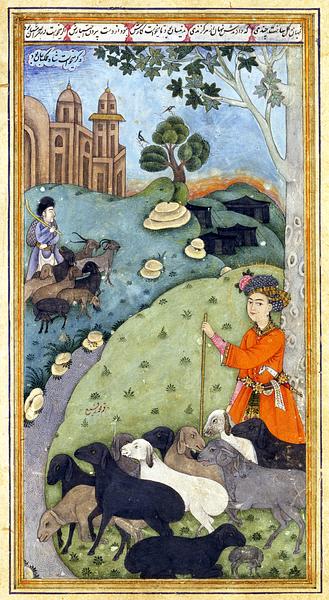Miniature from a copy of Jami’s Yusuf wa Zulaykha
Central Asia, Bukhara; 1095 H = 1683-1684
Miniature: 15.8 × 8.3 cm
A style was developed under the Sunni Shaybanids and Janids in Bukhara in the 16th and 17th century that differed to some extent from that of Safavid Iran, and in the 17th century, the influence of Mughal India was tangible.
The tale of Yusuf and Zulaykha is Jami’s much-loved retelling of the story of Joseph and Potiphar’s wife from the Old Testament and the Koran. On folio 78 of the manuscript, Muhammad Rafi depicted handsome Yusuf with his flock of sheep. He undeniably looks more like a courtier than a shepherd, with his colorful raiment, elegant Persian turban, and Indian dagger with horse-head hilt thrust into a bejeweled belt.
Inv. no. 43/2000
Published in:
fol. 10r
Ivan Z. Sørensen: Albondocani: Blixen og islam. Med Karen Blixens Kongesønnerne, København 2022, fig, 8, pp. 30-31;
fol. 78v
Kjeld von Folsach: Art from the World of Islam in The David Collection, Copenhagen 2001, cat.no. 40;
Kjeld von Folsach: For the Privileged Few: Islamic Miniature Painting from The David Collection, Louisiana, Humlebæk 2007, cat.no. 97;
Ivan Z. Sørensen: Albondocani: Blixen og islam. Med Karen Blixens Kongesønnerne, København 2022, fig, 25;
fol. 103r
Kjeld von Folsach, Joachim Meyer: The Human Figure in Islamic Art – Holy Men, Princes, and Commoners, The David Collection, Copenhagen 2017, fig. 47, p. 195;
Ivan Z. Sørensen: Albondocani: Blixen og islam. Med Karen Blixens Kongesønnerne, København 2022, fig, 28;
fol. 146v
Ivan Z. Sørensen: Albondocani: Blixen og islam. Med Karen Blixens Kongesønnerne, København 2022, fig, 30;
